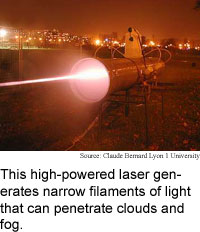
Laser bursts pierce fog
Researchers from Claude Bernard Lyon 1 University
in France have shown that it is possible to fire laser beams through otherwise
impenetrable clouds, haze and fog.
This means it could be possible to transmit data through these opaque
media and remotely sense objects or chemicals within clouds, haze or fog.
This could lead to more reliable free-space laser communications and new
ways to monitor pollution, according to the researchers.
Water droplets usually scatter laser signals. The researchers used
intense, very short laser pulses to form light filaments that were only
150 microns wide and hundreds of meters long, and showed that the filaments
could cut through water droplets as large as 95 microns without losing much
energy. One hundred fifty microns is only about one-third the size of a
red blood cell.
When the filament strikes a water droplet, much of the filament's
energy is transferred to surrounding photons. However, this energy is transferred
back to the filament on the other side of the droplet.
The researchers' next step is to check the phenomenon in the field
using a mobile femtosecond laser system. A femtosecond is one million billionth
of a second.
The work could find practical applications in two to five years,
according to the researchers. The work appeared in the July 14, 2003 issue
of Applied Physics Letters.
VR accommodates reality
Fractals support growing organs
Eyes off, screen off
Chip senses trace DNA
News briefs:
Laser bursts pierce fog
Electricity loosens tiny bits
Nano light stores data in polymer
See-through magnets hang tough
Munching microbes feed fuel cell
Crystal cracks nurture nanowires

Research Watch blog
View from the High Ground Q&A
How It Works
RSS Feeds:
News
Ad links:
Buy an ad link
Ad links: Clear History
Buy an ad link
|
TRN
Newswire and Headline Feeds for Web sites
|
© Copyright Technology Research News, LLC 2000-2010. All rights reserved.